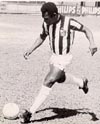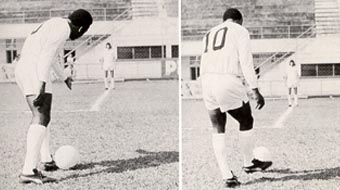|
 Play Soccer with Pelé
Play Soccer with Pelé
2. The Pass
It's very likely that you've learned at school about the different ways of
communicating. The radio, telephone, newspapers, magazines, books, cinema,
television, road, rail and river are means which men use to communicate with
each other. In soccer the pass is a form of communication, transmission,
participation, a link or contact. By passing, the players communicate with each
other, bringing the ball from their defense area up into attack. The better the
communication, the better are the chances of a successful team. Do you know
why? Soccer is a team game. There are eleven players working together and
that's why the original name of this sport is association soccer. The eleven
players are like partners; they help each other with the aim of scoring more
goals than the other team and, therefore, winning the game.
As there is only one ball on the pitch and only the
person who is in possession of it can score a goal, the pass is a method of
keeping the ball with your team. I hope
you've already realized that the pass is the most simple and safe way of your
whole side working towards a common end, and this is the case with all team
ball games.

There are many ways of passing the ball. The simplest
is the pass with the inside of the foot. This is also the most efficient
because the area of contact between the foot and the ball is larger, which
enables one to be more precise. For a longer pass you should use the top of the
foot because the impact is stronger. The outside of the foot can be used for
passes and diagonal kicks, especially when you are in possession of the ball
with an opponent right in front of you and your team-mate to your side.
It is possible to pass with your heel, knee, head or even your shoulder. But
some of these should only be used in an emergency. There is also what we call
an overhead pass. This should be done when your team-mate is well behind
the opponent. To execute this pass you should stab at the ball with the toe
striking underneath the stationary or rolling ball in front of you, so it rises
sharply and sails over your opponent's head and lands in front of your
colleague. Passing with the shoulder is a neat trick. Use the shoulder opposite
to the side on which your team-mate is running. Turn your body briskly
and keep your arms down.
About now you're probably asking-and what about the wall pass? I'll try to explain it. The wall pass is one of the quickest and
most perfect tactics in soccer. The player who is running with the ball
avoids a tackle from an opponent by passing to a stationary or running team-mate,
who acts as a wall by bouncing the ball back to the player who has now run
clear. The second player has to calculate, in a split-second, the weight
and direction to give the ball and anticipate exactly where his teammate will
end his run. If we had to make a geometric drawing of the wall pass it would
form a perfect triangle.

Another important tactic is the curved pass, which is
used to get the ball to a team-mate when the way is blocked by members of
the other side. To curve the ball, use either the inside or outside of the
foot, depending on whether you want the ball to curl round to the left or
right. Kick the side of the ball to make it spin like a top, thereby achieving
the desired curve. Have you ever heard of the 'radar' pass? In this one you
pass the ball without even seeing your team-mate as you have your back to
him. You judge his position only by the sound of his voice. For a successful
radar pass you really must know your team and the size of the pitch extremely well.
This may seem very difficult to you, as it did to me when I started, but with
constant practice you'll eventually find that it's not too complicated. You can
practice some of the passes against a wall. And don't forget to practice each
pass with your left foot as much as with your right.
Now do the same again, but this time with a few friends,
always trying to do better. It's also important to notice the position of your
support foot (that's the one that isn't kicking the ball). For a low pass, the
support foot should be parallel to the ball, right next to it. For a high or
long pass, place your foot by the side of the ball but a little further back.
Another detail which you shouldn't forget: it is the foot and knee of the supporting leg which give the
ball direction. The toe and knee of your support leg must be pointing directly
at your target, that is the friend to whom you are passing. This really works
and after training it becomes absolutely automatic. Before ending this lesson,
there are one or two important things I'd like to tell you about. Firstly, look
for the position of your team-mates before passing.
Secondly, the pass is not only made by the player with the ball, but also by the one who is
going to receive it. Do you understand? I'll explain. The ball cannot be passed
while the other player is being marked. Only he can dodge his opponents and get
into a free space. So it is the player to whom the pass is made who makes it
possible. The pass, like the whole game, is team work. Thirdly, and this is my
last piece of advice on this subject, when your team-mate is running into
a free space, don't pass directly to him, because when the ball arrives he
won't be there any more. You have to work out the speed and direction of the
other player and of the ball so they will both arrive at the same place at the
same time, without him having to slow down. If a rocket was pointed directly at
the moon at the time of launching it would miss its target completely after it
had traveled that distance! A moon shot has to be calculated with absolute
precision. Such precision and training are also essential in soccer.

Next Chapter: 3. The Header
Previous Chapter: 1. Controlling the Ball
Table of Contents
Top of Page
|

 Rate our web site. Answer our Questionnaire.
We care what you think. Click here
Rate our web site. Answer our Questionnaire.
We care what you think. Click here



 Rate our web site. Answer our Questionnaire.
We care what you think. Click here
Rate our web site. Answer our Questionnaire.
We care what you think. Click here

